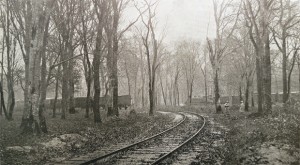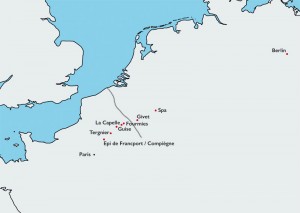Itinerary of German plenipotentiaries. © Paris, musée de l’Armée
 Pierre Toubeau, Deputy Chief of the Northern Network, took a few photographs, going against Foch’s orders. They show some of the carriages on both trains, the curbsided walkways connecting the trains having been retouched and adapted to the postcard format. In particular, Foch can be seen with his briefcase and cane walking along the German train track. © Paris, musée de l’armée.
Pierre Toubeau, Deputy Chief of the Northern Network, took a few photographs, going against Foch’s orders. They show some of the carriages on both trains, the curbsided walkways connecting the trains having been retouched and adapted to the postcard format. In particular, Foch can be seen with his briefcase and cane walking along the German train track. © Paris, musée de l’armée.
The Compiègne Wagons
“What I can say about the armistice can be summed up in two words: 1- full agreement with Marshal Foch on all points, except for the military personnel left in Germany: 2- complete disagreement with the President of the Republic on the first talks between Allies regarding the possibility of an armistice”.
Georges Clemenceau
The plenipotentiaries
It is customary for an armistice to be negotiated by a delegation that is in large part military. However, the composition of the German delegation departed from this principle. Hindenburg, who was not unhappy not to hold this responsibility, actually remarked to Erzberger: “This is the first time in history that politicians have concluded an armistice!”. Infantry general Erich von Gündell, initially announced, is withdrawn from the delegation. It is thus the Secretary of State for Foreign Affairs, Mathias Erzberger, Ambassador Alfred von Oberndorff, General Detlof von Winterfeldt, former military attaché in Paris speaking French, and the ship’s captain Ernst Vanselow who signed the armistice. Alongside them were Cavalry Captain von Helldorf, liaison officer and interpreter, Chief of Staff Geiger, two housekeeping officers and a civilian servant.
On the French side, Marshal Ferdinand Foch was accompanied by his Military Staff, including General Maxime Weygand, Commander Riedinger, Head of the 2nd Office, Captain of Mierry, Head of the 3rd Office, Interpreter Officer Laperche, Captain Boutal and Interpreter Officer Claude Pupier. The British delegation consisted of Admiral Rosslyn Wemyss, the first lord of the Admiralty, three Royal Navy officers — Commodore Hope, General Desticker and Vessel Captain Mariott — and an interpreter, Commander Bagot. In addition, many officers, soldiers and gendarmes were employed to ensure liaison, security and daily life of the two delegations.
Restaurant car 2419D
The famed Foch train, made up of ten wagons, was requisitioned, then fitted as a mobile command station during the major offensives. Foch left his headquarters in Senlis, on 7 November at 5 p.m., to join the firing spur in the Forest of Compiègne.



Ajouter un commentaire